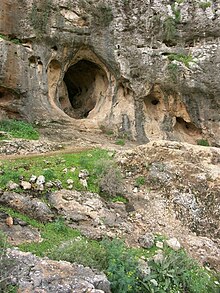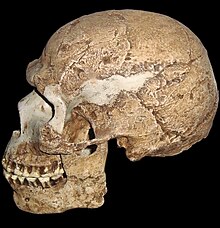Skhul
Skhul ( Arabic مغارة السخول Muġāret es-Sḫūl for: den of the goat fawns , Hebrew מערת הגדי) is the name of a cave in today's Nachal Me'arot nature reserve in the Carmel Mountains ( Israel ) near Athlit , just under 20 kilometers south of Haifa . During excavations in the forecourt of the cave under the direction of Theodore Doney McCown, important graves of anatomically modern humans ( Homo sapiens ) were uncovered in 1931 and 1932 . The small karst cave and the associated forecourt are located on the southern edge of the valley of the Wadi el Mugharet (Valley of the Caves), which emerges in a westerly direction from the Carmel massif towards the Mediterranean coast. About 100 meters down in the wadi is the Tabun Cave , and even closer to the same edge of the valley is the cave el-Wad (Muġāret el-Wād) with the Natufien open-air site El-Wad in front of it .
Find history
The name of the cave goes back to the shepherds who locked the kid goats here after they were weaned from their mothers in order to keep them out of the flock's hearing and sight during the weaning phase . The small cave was examined by Dorothy Garrod in 1928 , but without any result. Theodore D. McCown , then scientific assistant to Garrod, discovered nine graves (Skhul I to IX), which were then called Mount Carmel Neanderthals , during systematic excavations in 1931 and 1932 in layers of the shallow forecourt of the cave . They come from layer B of the Moustérie , the middle layer of the three-part stratigraphic sequence. Other bones were later recovered that can be attributed to at least one other individual. In 1939 the human fossils were monographed by Arthur Keith and Theodore McCown. Missing bone parts were partly added after the preparation without any concrete clues, so that today it is sometimes difficult to reconstruct the original anatomical condition.
The mostly incomplete graves I to X contained the following fossil bones:
- Skhul I: cranial roof of a child, without facial bones, with partially preserved lower jaw , partially dentate, molar M1 has not yet broken through (together with Skhul V best fossil preservation)
- Skhul II: fragments of the skull of an adult and fragments of the associated lower jaw
- Skhul III: parts of the left leg of an adult, presumably male, individual
- Skhul IV: an almost completely preserved skeleton of a presumably male adult with a heavily fragmented skull, incomplete facial bones and an almost completely dentate lower jaw
- Skhul V: a largely completely preserved skull of an older adult with completely preserved, heavily chewed upper jaw teeth and strongly fragmented lower jaw
- Skhul VI: parts of the skeleton of a man estimated at 30 to 35 years
- Skhul VII: Parts of the skeleton of a woman estimated at 35 to 40 years
- Skhul VIII: leg bones of a child
- Skhul IX: Parts of the skeleton of a man estimated to be 50 years old
- Skhul X: parts of the lower jaw, teeth and humerus of a child
Dating and interpretation of the finds
Different information is given in the specialist literature on the age of the finds. For example, in 1998 thermoluminescence dating for layer B was 119,000 ± 18,000 years; an electron spin resonance -Datierung had surrendered the previous maximum of 101,000 ± 12,000 and a minimum of 81,000 ± 15,000 years. The age is therefore occasionally given - in a quasi-summarizing manner - 80,000 to 120,000 years, 80,000 to 100,000 years, or 100,000 years are given as an approximation.
Fossils came to light in three layers of finds of different ages, which among other things could be distinguished from one another due to a differently composed animal world; all hominine fossils come from the layer B. These fossils were assigned to a " hybrid " culture known as Levalloiso-Mousterian based on the initial interpretation of thousands of stone tools that were also found , since at that time they were from an older stage of "Levalloisia" (culture with Levallois technique ) and a last glacial Moustérien was assumed as the tool culture of the Neanderthals. Furthermore, it was argued - primarily by Arthur Keith - that the structure of the bones found indicated that the Neanderthal finds from the Tabun Cave and the Amud Cave, and in particular the Skhul IV, V and IX finds, represented a single species that In 1939 McCown and Keith named it Palaeoanthropus palestinus . The existing differences between the fossils from different caves were interpreted as intra-species variability due to a rapidly evolving lineage . However, as early as 1939 - on Theodore McCown's initiative - it was not completely ruled out that the fossils discovered in the Carmel Mountains could possibly represent two related taxa : McCown had the finds from the Tabun Cave - also rightly from today's perspective - as rather " neanderthaloid ”(similar to the Neanderthal man) interpreted, the findings of Skhul as more closely related to the Cro-Magnon people .
Today the cave is mainly considered to be the burial place of early anatomically modern people who lived in the Carmel Mountains at the same time or in multiple temporal alternations with Neanderthals.
Web links
- ntropogenez.ru : Side view of the Skhul V fossil
- Sifting through half a million years of human history. On: nature.com from August 3, 2020.
Individual evidence
- ↑ Dorothy Garrod: Excavations in the Mugharet el-Wad, near Athlit, April-June 1929. Quarterly Statement of the Palestine Exploration Fund 61, pp. 220-222
- ↑ Salomon, H .; Vignaud, C .; Coquinot, Y .; Beck, L .; Stringer, C .; Strivay, D .; D'Errico, F .: Selection and Heating of Coloring Materials in the Mousterian level of es-Skhul (c. 100,000 Years BP, Mount Carmel, Israel). In: Archaeometry 54 (4), 2012, pp. 698-722
- ↑ Arthur Keith , Theodore McCown: The Stone Age of Mount Carmel. Vol. II: The Fossil Human Remains from the Levalloiso-Mousterian. Oxford University Press at the Clarendon Press, Oxford 1939
- ↑ Jeffrey H. Schwartz , Ian Tattersall et al: The Human Fossil Record. Volume 2: Craniodental Morphology of Genus Homo (Africa and Asia) , Wiley, 2003, pp. 358 ff., ISBN 978-0-471-31928-3
- ↑ Book Review of Ashley Montagu in American Anthropologist f, Volume 42, 1940, S. 518th
- ↑ N. Mercier et al .: Thermoluminescence Date for the Mousterian Burial Site of Es-Skhul, Mt Carmel. In: Journal of Archaeological Science , Volume 20, No. 2, 2003, pp. 169-174, doi : 10.1006 / jasc.1993.1012
- ↑ Chris Stringer et al .: ESR dates for the hominid burial site of Es Skhul in Israel. In: Nature , Volume 338, 1989, pp. 756-758, doi : 10.1038 / 338756a0
- ↑ for example in the online edition of the Encyclopædia Britannica
- ↑ Wesley A. Niewoehner: Behavioral inferences from the Skhul / Qafzeh early modern human hand remains. In: Proceedings of the National Academy of Sciences , Volume 98, No. 6, 2001, pp. 2979-2984, doi : 10.1073 / pnas.041588898
- ↑ heise.de of June 28, 2006: Shell chain as a status symbol. Our ancestors wore jewelry 100,000 years ago.
Coordinates: 32 ° 40 ′ 14.4 " N , 34 ° 57 ′ 58.1" E



